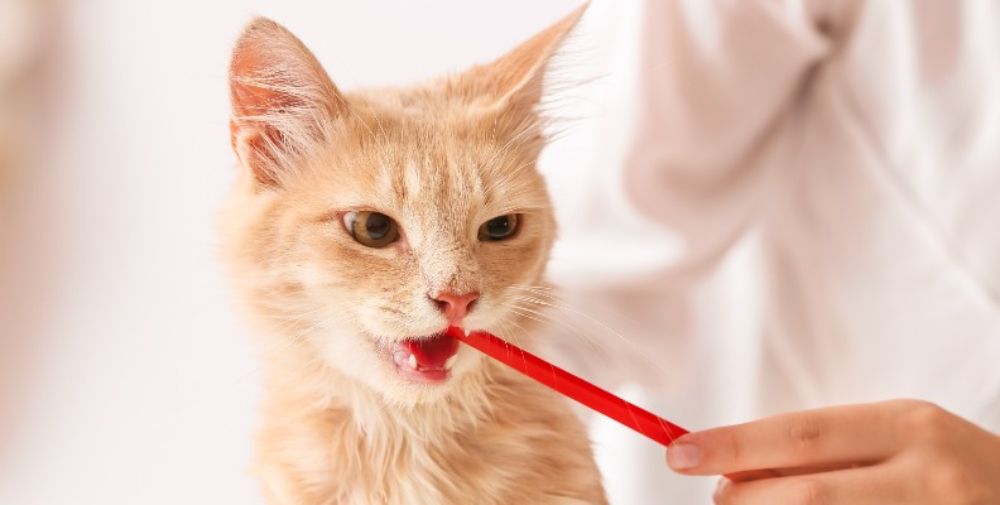Cats are rubbish at dental care - they never show up to dentist appointments and flossing just makes them angry. But they can develop dental problems just like human teeth can. So you need to pay attention to your cat’s oral health and include regular toothbrushing into their routine as well as dental checks to help to avoid pain, discomfort and costly dental treatment.
So to help you out, Everypaw's vet, Dr Anna, is here to show you how to clean your cat's teeth.
How to Open Your Cat’s Mouth
Put your cat on a table, and then use your arm to hold it against you.
Carefully grasp its head by placing your thumb just above its jawline, and slowly tilt its head so one ear is facing the floor. Gently pull its lower lip/jaw down with the other hand so you can see its teeth and gum line. Repeat on the other side, giving them some fuss in between.
This can be tricky – some cats will tolerate you looking at their teeth, while some won’t. Try to get them used to this when they’re young. If your cat gets too angry, try again another day.
What to Look For When You Clean Your Cat's Teeth
Once your cat is comfortable, you can check for signs of unhealthy cat teeth, e.g. the colour of your cat’s teeth, gums and whether they have bad breath. Cat’s teeth should look reasonably white, yellow is a sign of plaque, while darker colours are a sign of tartar.
Plaque is a yellow-white deposit that is a mixture of bacteria and debris that forms around the surface of the teeth. Plaque hardens over time to form yellow-brown tartar (or calculus) and can lead to periodontal disease.
Check the colour of your cat’s gums too – they should be a healthy pink, not too dark or light. Gum (gingiva) inflammation is known as gingivitis. This painful condition can lead to tooth abscesses and loose teeth.
Also check if your cat has bad breath and if they have difficulty eating – these are signs that your cat may have dental problems. Cats are experts at hiding pain so spotting any dental issues early is very important.
Do I Need to Brush My Cat’s Teeth?
Cats now tend to be fed a soft, wet diet– not ideal for keeping their teeth strong and healthy. Adding more dry food to their diet is a good start to keeping their teeth in good condition. Ask your vet for advice on special diets, treats and chews designed for dental care. However, the most important thing is brushing your cat’s teeth!

How to Clean Your Cat’s Teeth
Get them used to having their teeth cleaned from an early age. You can start by just rubbing their teeth with your finger covered by a soft gauze and then move on to using a pet toothbrush and pet toothpaste. Mini toothbrushes that fit over your index finger can also be used.
Don’t use human toothpaste, it will froth too much, and your cat will not like the taste. Toothpaste for cats comes in tasty flavours such as fish or chicken – if they don’t like one brand, try another. Some contain enzymes to help control plaque. And remember, introduce tooth brushing slowly:
- To start with a soft cloth can be used to wipe the teeth, front and back. Do this twice daily and after about two weeks your cat should be accustomed to the procedure.
- Then using a cat’s toothbrush, soak the toothbrush in warm water and start brushing twice daily for several days, only adding the toothpaste once your pet accepts the brushing.
- The toothpaste should be placed between the bristles rather than on top - this allows the paste to spend the maximum possible time next to the teeth. Place the toothbrush bristles at the gum edge where the teeth and gum meet and then move the brush in an oval pattern. The bristle ends should go into the area around the base of each tooth and into the space between the teeth. Complete ten short back-and-forth motions, covering three to four teeth at a time. Pay most attention to the outside of the upper teeth.
Make toothbrushing part of your cat’s daily routine. It may involve time and patience before they get used to it but it’s worth persevering as it will reduce the risk of advanced dental disease developing.
Everypaw Cat Insurance
Everypaw's Cat Insurance comes with 24/7 unlimited access to vets and vet nurses that can help with your pet's health, care, nutrition and behaviour. So you can rest assured your kitty will be well looked after.
If you take out an Everypaw Cat Insurance policy, dental cover is included in your vet fee cover. You just need to make sure you look after your cat's teeth, take them for regular check-ups and make sure you follow your vet's advice.